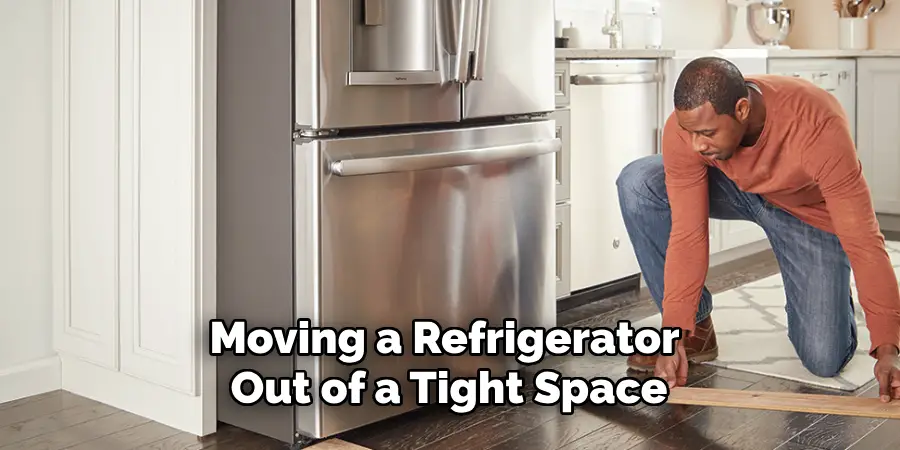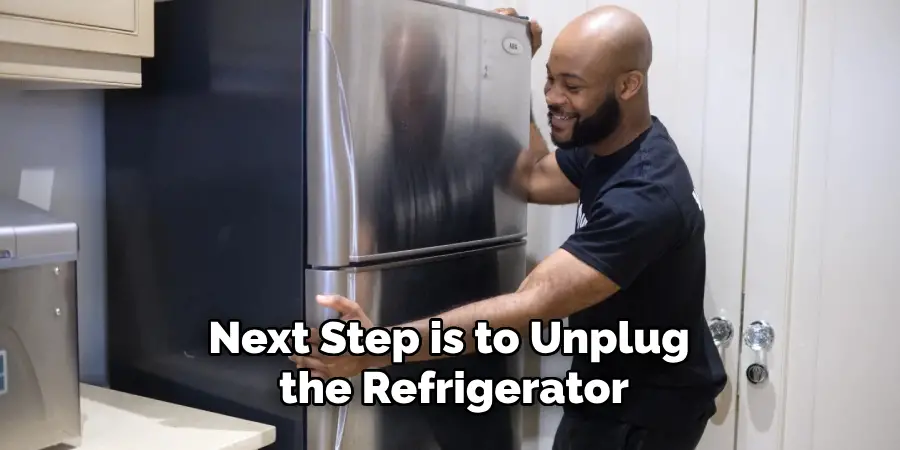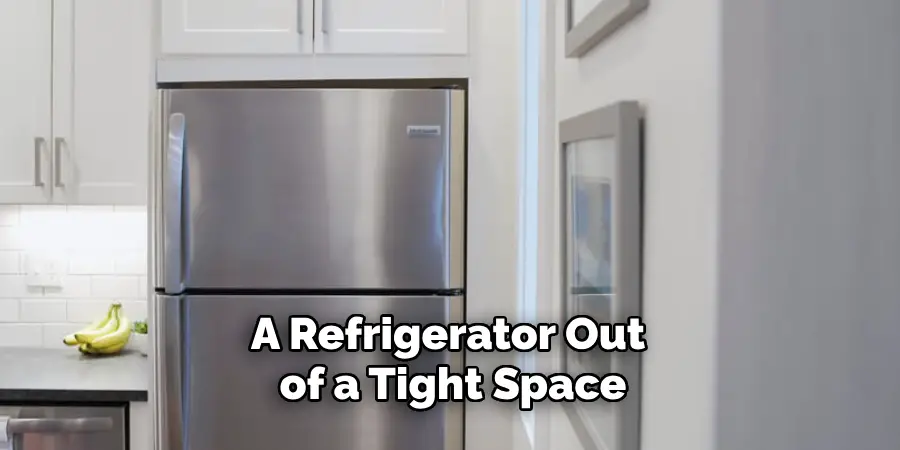Moving a refrigerator out of a tight space can be a daunting task, but with the right preparation and technique, it can be accomplished efficiently and safely. Whether you’re rearranging your kitchen or replacing your old appliance, knowing how to navigate narrow doorways, small hallways, and confined areas is crucial.
This guide on how to move a refrigerator out of a tight space will provide you with step-by-step instructions to ensure you protect both your refrigerator and your home from potential damage during the moving process. With a little patience and the right strategy, you’ll be able to move your refrigerator without unnecessary hassle.

Why is It Important to Move a Refrigerator Correctly?
Before we dive into the steps, let’s first discuss why it’s crucial to move a refrigerator out of a tight space correctly. Refrigerators are heavy and bulky appliances, making them difficult to maneuver in small spaces. If not handled properly, you risk damaging not only your fridge but also your walls, floors, and other furniture.
Moreover, refrigerators contain delicate internal components that can easily get damaged if the appliance is jolted or tilted during the moving process. Therefore, it’s essential to follow the proper techniques when moving a refrigerator out of a tight space to avoid any unnecessary expenses and headaches.
Things to Consider Before Moving Your Refrigerator
- Measure the Dimensions of Your Fridge and the Space You Need to Move It Through to Ensure It Will Fit.
- Have a Clear Path From the Current Location of the Refrigerator to Its New Spot.
- Empty the Refrigerator and Freezer Compartments to Reduce the Weight and Avoid Any Potential Spills or Leaks.
- Gather All Necessary Tools and Equipment, Such as a Dolly, Furniture Straps, and Moving Blankets, Before Starting the Process.

8 Steps on How to Move a Refrigerator Out of a Tight Space
Step 1: Prepare the Space
Before you begin moving the refrigerator, it’s vital to prepare the space to ensure a smooth and safe relocation. Start by clearing the path between the refrigerator and its new location. Remove any obstacles, like furniture, rugs, or decorative items, that might hinder movement or create tripping hazards.
Make sure doorways are wide enough for the refrigerator to pass through by temporarily removing doors if necessary. It’s also a good idea to protect your floors throughout this path by placing cardboard or furniture sliders under the appliance to prevent scratches or damage. Preparing the space helps to streamline the moving process and minimize the risk of damage to both the refrigerator and your home.
Step 2: Unplug the Refrigerator
Once the space is prepared, the next step is to unplug the refrigerator. Begin by locating the power cord, which is typically accessible at the back of the appliance. Carefully unplug it from the wall outlet to ensure the refrigerator is completely disconnected from any power sources. It’s important to allow the refrigerator some time to defrost if it has built-up ice inside the freezer compartment. This step helps prevent any potential water leakage during the moving process.
Additionally, if your refrigerator has a water dispensing system, disconnect the water line to avoid spills. Ensuring the appliance is entirely unplugged and disconnected not only protects the internal components but also reduces the risk of electric shock during the move.

Step 3: Empty the Contents of the Refrigerator
Remove all food, shelves, and drawers from your refrigerator and freezer compartments. This step helps to reduce the weight of the appliance, making it easier and safer to move. It also prevents any potential spills or leaks during transportation that can damage your floors or other belongings.
Before emptying the fridge, make sure to properly label any food items you plan on keeping, so they don’t spoil during the moving process. For perishable foods like meat, dairy, or produce, consider storing them in a cooler with ice packs until you’re ready to transfer them back into the refrigerator.
Step 4: Secure Loose Parts
Refrigerator doors, shelves, and drawers can easily swing or slide out during the move, causing unnecessary damage. To prevent this from happening, secure all loose parts by taping them in place or using furniture straps. This step helps to keep the refrigerator’s internal components intact and minimizes the risk of any accidents while moving it.
It’s also a good idea to remove any detachable parts, like the water dispenser or ice maker, and pack them separately for added protection. Be sure to label these parts and store them in a secure place, so they don’t get misplaced during the move.
Step 5: Use a Dolly
A dolly is an essential tool when it comes to moving heavy appliances like refrigerators. It helps distribute the weight evenly, making it easier to maneuver without putting too much strain on your back. When using a dolly, make sure to load the refrigerator with its front facing toward the dolly’s handle. This position provides better control and stability while pushing or pulling the appliance.
Before tilting the dolly, secure the refrigerator with furniture straps for added support and tie down any loose parts that might shift or fall off during transportation.
Step 6: Tilt and Slide
Once the refrigerator is loaded onto the dolly, tilt it back gently towards you and start moving it out of the tight space. If you’re moving the appliance downstairs, make sure to have a helper to support and guide the dolly from behind.
It’s important to move slowly and carefully while tilting the refrigerator to avoid any sudden movements that can cause damage or injury. Use furniture sliders or cardboard to protect your floors during this process.
Step 7: Navigate Through Doorways
When moving through doorways, use caution and take your time. Make sure someone is holding open the door for you as you maneuver the dolly with the refrigerator. Keep a close eye on any potential obstacles or uneven surfaces that can cause the dolly to tip over.
If your refrigerator is too tall to fit through the doorway, you may need to tilt it horizontally while still on the dolly and carefully maneuver it through by rotating it. This technique requires extra caution and strength, so make sure you have enough support from your helper.

Step 8: Safely Place the Refrigerator in its New Location
Once you’ve successfully navigated through doorways and tight spaces, it’s time to carefully place the refrigerator in its new spot. When unloading from the dolly, make sure someone is holding onto the appliance for added stability and control.
If you’re moving the refrigerator upstairs, make sure to have a helper guide and support it from behind while you control the dolly from the front. Once in its new location, gently set down the appliance and remove any furniture straps or tape securing it.
Following these steps on how to move a refrigerator out of a tight space can help make the process of moving a refrigerator much smoother and safer. It’s important to take your time, use caution, and have proper help when needed. With some preparation and careful handling, you can successfully relocate your refrigerator without any damage or accidents.
Additional Tips for Moving a Refrigerator
- Measure doorways and pathways beforehand to ensure the refrigerator will fit through without any issues.
- Cover the refrigerator with moving blankets or plastic wrap for added protection during transportation.
- Consider hiring professional movers if you’re not comfortable or physically able to move the refrigerator on your own.
- Wait at least 24 hours before plugging in and turning on the refrigerator in its new location to allow the internal components to settle.
- Refer to the manufacturer’s instructions for specific guidelines on moving your particular refrigerator model.
Moving a refrigerator out of a tight space can be challenging, but with these steps and additional tips, you can safely and successfully relocate your appliance without any damage or accidents. Remember to always prioritize safety and have proper help when needed.
Frequently Asked Questions
Q: Can I Transport a Refrigerator in an Upright Position?
A: Yes, it’s generally recommended to move refrigerators in an upright position. However, if you need to transport the appliance horizontally, make sure it’s secured tightly and not tilted more than a 45-degree angle. The refrigerator should also be kept in a vertical position for at least 24 hours before plugging it in.
Q: How Do I Prepare My Fridge Before Moving?
A: To prepare your fridge for moving, make sure to empty and clean it thoroughly, secure any loose parts or shelves, and unplug and defrost the appliance if necessary.
Q: Can I Leave Food in My Refrigerator During a Move?
A: It’s best to try to consume or discard all perishable food items before moving. However, if you have non-perishable items that are securely packed and won’t spoil during transportation, you can leave them inside the refrigerator. Just make sure the door is securely closed and the unit is properly secured during the move.

Conclusion
Moving a refrigerator out of a tight space can be challenging, but by following these 8 steps, you can ensure a safe and successful relocation without causing damage to your home or appliance. Remember to always prioritize safety by preparing the space, unpugging the refrigerator, securing loose parts, and using proper equipment like dollies and furniture straps.
With these tips on how to move a refrigerator out of a tight space in mind, you can smoothly move your refrigerator to its new location without any hassle. So, whether you’re moving into a new home or rearranging your current space, these steps will help make the process more efficient and stress-free.
About
Angela is the chief editor of Indoorense. She began her career as an interior designer before applying her strategic and creative passion to lifestyle and home.
She has close to 15 years of experience in creative writing and online content strategy for housekeeping and cleaning,home decorations as well as other efforts.
She loves her job and has the privilege of working with an extraordinary team. She lives with her husband, two sons, and daughter in Petersburg. When she’s not busy working she spent time with her family.

